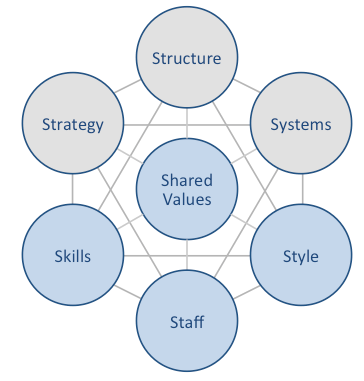Xiaomi McKinsey 7S Model
Xiaomi McKinsey 7S model illustrates the ways in which seven elements of businesses can be aligned so that overall effectiveness can be increased. According to the framework strategy, structure and systems are hard elements, whereas shared values, skills, style and staff are considered as soft elements.
McKinsey 7S model stresses the presence of strong links between elements in a way that a change in one element causes changes in others. As it is illustrated in figure below, shared values are positioned at the core of Xiaomi McKinsey 7S model, since shared values guide employee behaviour with implications in their performance.

Xiaomi McKinsey 7S Model
Hard Elements
Strategy. Xiaomi business strategy is based on cost leadership. Company’s business strategy also integrates gathering and utilising a large fan base and aggressively increasing the ecosystem of products and services. Moreover, Xiaomi positions itself as an internet and software company rather than a hardware company. Accordingly, the sales of hardware are perceived as a means to deliver software and services in the long-term perspective.
Structure. Xiaomi has a matrix organizational structure. The electronics and software company has various business units that are managed independently. Xiaomi organizational structure can also be also classified as flat. Despite its large size employing more than 18000 people in 70 countries, the company has only a few layers of management.
Systems. Xiaomi’s business depends on a wide range of systems such as employee recruitment and selection system, team development and orientation system and transaction processing systems. Moreover, there are critically important systems for the company such as customer relationship management system, business intelligence system, and knowledge management system. The mobile internet company aims to increase the efficiency of these and other systems via the integration of internet-based information technologies.
Xiaomi Inc. Report contains a full analysis of Xiaomi McKinsey 7S Model. The report illustrates the application of the major analytical strategic frameworks in business studies such as SWOT, PESTEL, Porter’s Five Forces, Ansoff Matrix and Value Chain analysis on Xiaomi. Moreover, the report contains analyses of Xiaomi leadership, business strategy organizational structure and organizational culture. The report also comprises discussions of Xiaomi marketing strategy, ecosystem and addresses issues of corporate social responsibility.

